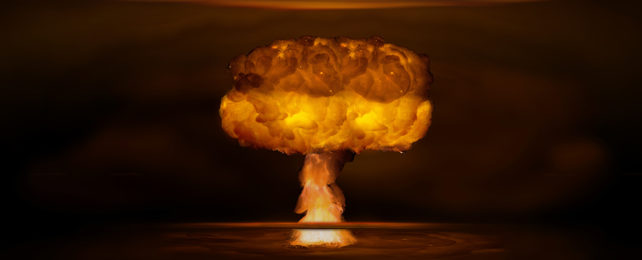It starts with a single mushroom-shaped cloud the world hoped to never see again.
Retaliation prompts tit-for-tat attacks, each intended to end this latest War of All Wars, until a week or so later Earth begins to shiver beneath a pall of soot and dust.
Scenarios mapping and calculating the devastation of a nuclear winter are nothing new, dating back to a time when the Cold War was nightly news.
Decades on, we know a lot more about the finer effects of particulates in the atmosphere on our agriculture. And the sums remain as grim as ever.
Using the latest data on crop yields and fisheries resources, a group of scientists from around the globe have proposed six scenarios approximating what we might expect of food supplies in the aftermath of a rapidly escalating nuclear conflict between warring states.
Setting aside the immediate casualties in the attacks, which could be in the hundreds of millions, the mortality rate from a calories shortage crisis alone could wipe out most of the world's population.
The researchers used the National Center for Atmospheric Research's Community Earth System Model to predict how weather patterns might change with the addition of soot and dust churned up by nuclear blasts.
This was then used to inform estimates on how yields in crops and marine stocks would react to shifts in surface temperature, direct and diffuse light, and precipitation.
The results weren't pretty. Take a relatively minor nuclear bombardment involving around 100 detonations, such as one we might anticipate should tensions between India and Pakistan boil over.
By the researchers' calculations, 5 million metric tons of particulates would be cast into the atmosphere. For a comparison, the catastrophic wildfires in California in 2017 and those in Australia at the end of 2019 emitted as much as 1 million metric tons each.
The consequences would mean most of us would have access to 8 percent fewer calories, with up to 255 million people succumbing to famine over the following years. Ironically, adjustments in how we feed ourselves might even lead to some communities piling more on their plates, increasing their intake by up to 5 percent.
As the soot in the air builds with greater numbers of nuclear bombs, it would only get harder to find ways to meter out food resources, even for those wishing to exploit the chaos.
An all-out-war that depleted US and Russian stockpiles of thousands of bombs would add 150 million metric tons of grit and dust to our planet's atmosphere, depriving the world of three-quarters of their calories.
Shuffling animal feed stocks into emergency supplies and eating what we now waste would only get us so far – it would be a slow starvation for 5 billion people around the globe as they struggle to get enough food to survive over the next two years.
Ready access to a food supply would depend on where a population lives. In a scenario where 250 nuclear blasts throw 27 million metric tons of material into the air, high latitudes in the Northern Hemisphere would see a drop of more than 50 percent in harvested calories, and around 20 to 30 percent decline in fishing reserves.
For nations nearer to the equator, the average reduction in calories would be less than 10 percent.
As witnessed in the conflict between Ukraine and Russia, trade in food would almost certainly be interrupted. Nations dependent on food shipped in from elsewhere would need to quickly adjust.
For some communities, this might not be as bad as it sounds.
Without an international trade supplementing their diet, Australia's population could still get at least half of their calories from spring wheat. Simulations conducted by the researchers found this crop would experience a minimal drop in yield, or perhaps even a slight gain.
While Australians would still need to tighten their belts, the same level of casualties might be avoided. Likewise, New Zealand's food supply could face a smaller impact than nations that rely on crops like rice.
As the researchers note, however, the sociopolitical turmoil that would inevitably follow turns relatively straight-forward predictions on food economics into a chaotic mess.
"But if this scenario should actually take place, Australia and New Zealand would probably see an influx of refugees from Asia and other countries experiencing food insecurity," the authors note.
While the study advances past predictions with more accurate data, there are still plenty of unknowns when it comes to ways humanity would struggle in the wake of a nuclear war.
Future measures could take advantage of improved models involving more crops, or predict how systems of trade and economics would redistribute goods.
Other factors, such as the loss of ozone, and deaths of pollinators, would also go some way in affecting managed and unmanaged resources. Taking these into account could see our mortality rate grow even further.
Not that we'd ever want to find out for certain just how accurate our predictions might be. For now it's a hypothetical outcome we can only hope leaders of nuclear nations keep in mind.
This research was published in Nature Food.
